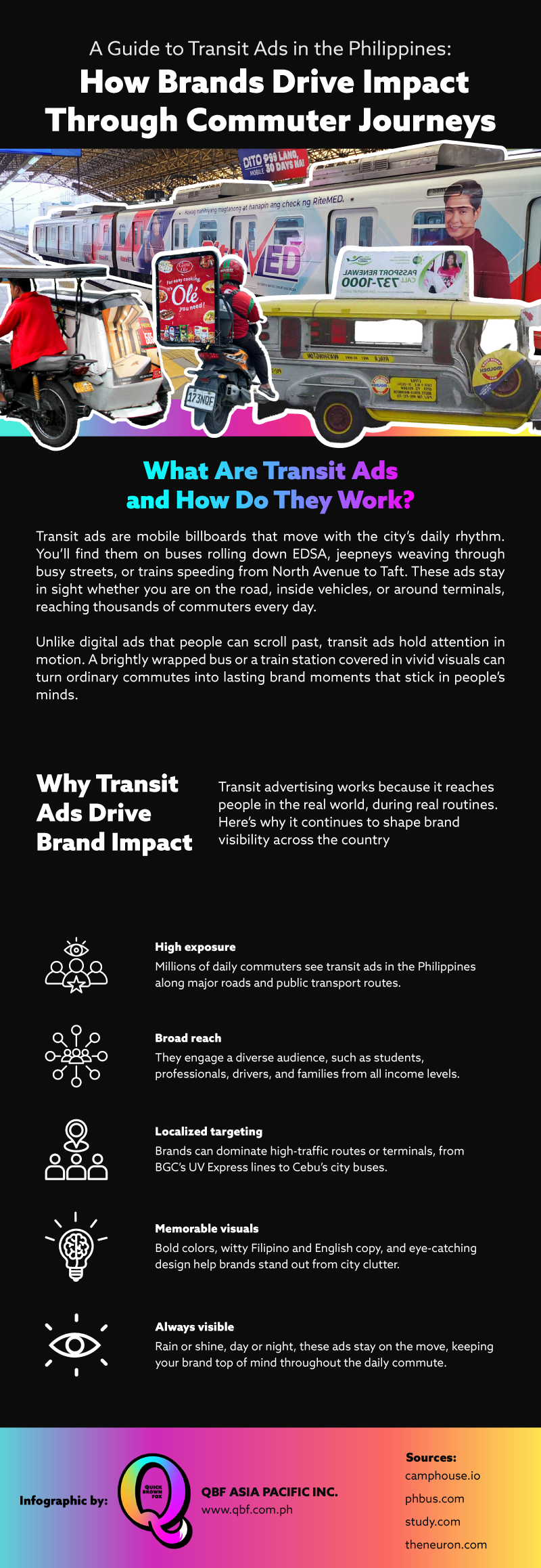Key Takeaways
Transit ads help brands make a strong, lasting impact by blending visibility, repetition, and creativity. They reach audiences in motion and turn commutes into brand experiences.
- High exposure in crowded urban areas
- Repeated visibility builds a stronger brand recall
- Immersive, mobile formats engage daily commuters
- Flexible designs fit different routes and audiences
Every day, millions of Filipinos move through a rhythm of horns, footsteps, and rushing wheels. Buses crawl along EDSA with passengers staring out their windows. Jeepneys load and unload in Cubao’s heat. Inside the LRT, office workers scroll through their phones, half-awake before another long day. These familiar scenes are more than just movement; they’re moments of attention.
Across these routes, vibrant colors and bold visuals flash by: logos on bus wraps, witty jeepney slogans, and sleek train station panels. Transit ads are part of one of the most visible forms of out-of-home advertising in the country.
This guide explores how transit ads in the Philippines shape the commuter experience, the formats that dominate local streets, and how brands can plan smarter, more impactful campaigns that move with the people.

What Are Transit Ads and How Do They Work?
Every city in the Philippines moves to its own rhythm—buses inching through EDSA, jeepneys weaving from Divisoria to Quiapo, and MRT trains rushing above Ortigas traffic. In these spaces, transit ads travel with commuters, turning vehicles and stations into moving or stationary billboards that follow the same routes Filipinos take daily.
Transit advertising includes any ad placed on or within public transportation, like buses, jeepneys, trains, UV Express vans, taxis, and terminals. These ads move across massive distances, reaching people from Quezon City to Makati, or Manila to Baguio. A single campaign can gain thousands of impressions daily without relying on screens or clicks.
What makes transit ads in the Philippines effective is repetition. Commuters see the same visuals every day, which builds strong recall. That bright red bus wrap or branded MRT pillar becomes part of their routine. The constant exposure reinforces memory—turning attention into familiarity, and familiarity into trust.
Popular Forms of Transit Ads in the Philippines
Transit advertising thrives because of the country’s diverse public transport system. From Metro Manila’s busy highways to terminals in Cebu or Davao, every route offers a chance to connect with people in motion.
Bus wraps and panels
Buses along EDSA, Commonwealth, or C5 act as massive moving billboards. Full-body wraps and side-panel ads reach drivers, pedestrians, and commuters alike. Big brands like telecoms and fast-food chains dominate these routes for wide city coverage.
Jeepney wraps and stickers
Jeepneys, the icons of Filipino life, double as creative canvases. Their colorful designs reflect humor and culture, making them perfect for brands with mass appeal. Ads on jeepneys bring visibility to busy neighborhoods from Caloocan to Cebu City.
MRT and LRT placements
Inside train systems, ads cover interior walls, LED screens, and station platforms. Think of looping videos at MRT Ayala or posters along LRT2 Cubao. These placements target a captive audience that sees the same visuals daily, strengthening brand recognition.
UV Express and taxi ads
Smaller vehicles like UV Express vans and taxis offer targeted reach. Common in high-traffic areas like BGC and Makati, they connect with professionals and urban dwellers. Their proximity makes the ads feel more personal when seen up close during traffic.
Transport terminal branding
High-foot-traffic areas like PITX, NAIA, and Davao Overland Terminal provide opportunities for large-format executions like LED walls, branded waiting areas, or ticket counters. These transform waiting time into brand time.
Transit Ads Examples That Make an Impact
Effective transit ads examples connect emotionally with Filipino commuters. They catch attention, trigger curiosity, and often become part of local culture.
Bus ads with bold visuals
Imagine a bright yellow bus wrapped in a fast-food campaign. A celebrity smiles beside a catchy tagline everyone recognizes. These designs dominate the road and often go viral on social media, which doubles the ad’s reach.
Jeepney campaigns that resonate
Brands fluent in Filipino humor and visual storytelling thrive in jeepney campaigns. Think detergent or snack brands using witty Tagalog puns. These jeepneys drive through markets and residential streets, meeting people where they live.
Train station takeovers
An MRT or LRT station fully branded for a launch is hard to miss. Telecom and tech brands often cover walls, pillars, and floors during peak campaigns. Stations like Shaw or Taft become immersive brand spaces for thousands of commuters daily.
Why Transit Ads Drive Brand Impact
Transit ads work because they reach people on the road or in transit hubs. They blend into daily life while staying visually unavoidable.
High exposure and frequency
Millions of commuters pass the same buses, jeepneys, and train stations daily. Repeated exposure cements brand familiarity such as people recognize the logo long before reading it.
Broad audience reach
Transit ads cut across demographics. Students, office workers, vendors, and drivers all share the same routes. This inclusivity makes transit ads in the Philippines one of the most effective mass-reach media options.
Geo-targeted visibility
Unlike fixed billboards, transit ads move. Brands can target specific routes or regions—a coffee brand in BGC vans for young professionals or a food chain on Cebu buses for families.
Strong brand recall
Large visuals, striking motion, and relatable copy grab attention. Filipinos often share clever ads online, giving campaigns organic reach beyond their physical location.
Best Practices for Planning Effective Transit Ad Campaigns
Running a strong campaign means balancing creativity with strategy. It’s about combining design with visibility, timing, and execution.
Choose the right format and route
Start with your target audience. Bus wraps along EDSA work for citywide reach, while jeepneys boost hyperlocal visibility. MRT or LRT ads engage urban professionals. Match routes to your
audience’s routine for maximum impact.
Design for movement
Commuters have only seconds to notice an ad. Keep text short, use bold colors, and make visuals clear from a distance. High-contrast, simple designs perform best in traffic or poor weather.
Integrate with digital
Combine physical reach with digital engagement. Add QR codes or hashtags to bus wraps and station posters. This bridges offline visibility with online interaction—turning interest into measurable results.
Secure compliance and maintain quality
Each city has its own rules for transit ads. Get permits early and keep visuals clean and intact. Faded or torn wraps hurt credibility; scheduled maintenance preserves brand quality.
Partner with an experienced OOH provider
Execution matters as much as creativity. A trusted partner like Quick Brown Fox (QBF) can manage every stage—from concept and design to printing, installation, and compliance.
The Road Ahead
Transit advertising remains one of the most immersive ways to reach Filipinos. It’s visible, consistent, and deeply woven into urban life, which is ideal for brands seeking real-world presence beyond digital screens.
To expand your campaign beyond billboard advertising in the Philippines, work with experts who understand local routes and commuter behavior. Quick Brown Fox delivers complete OOH solutions, from conceptualization to installation, backed by years of experience in nationwide rollouts for major brands.
Turn your next campaign into a journey that moves with your audience. Contact Quick Brown Fox to bring your brand to life across the Philippines.
FAQs
Transit ads are brand visuals placed on public transport like buses, jeepneys, and trains. They work by reaching commuters throughout their daily routes, ensuring repeated exposure and high visibility.
Popular formats include bus wraps, jeepney decals, MRT/LRT posters, and terminal displays. These reach thousands of passengers daily, making them one of the most effective outdoor ad strategies.
They reach audiences in constant motion, ensuring daily visibility across urban routes. This consistency helps brands stay top-of-mind, especially for commuters who see the same routes every day.
You can partner with experienced OOH providers like Quick Brown Fox, which offers full-service solutions—from creative design to installation—for nationwide billboard advertising in the Philippines and transit campaigns.

